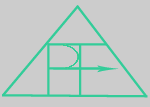INTERROGATION OF A FIRE ANT BY THE GERMAN FEDERAL BORDER POLICE
Following the historically very long tradition around the creation of collages, artist P. – A. Fritze developed what are referred to as ‘ARTE POVERA COLLAGES’ in the 1980s. The material used in this case is actually extremely sparse – indeed, it is almost impoverished. The choice of ‘newsprint’ as the basic material is not dictated by the motifs presented here in this medium. Instead, the artist deliberately opts for ‘ordinary’ newsprint as a design feature within the meaning of the ARTE POVERA TRADITION. The work entails a rigorous selection of photographs from the then-current daily press. Use of this material is justified by the fact that it is also the simplest and most inexpensive medium available: the newsprint that is usually quickly thrown away.
At the time, as we recall, most of the image material in newspapers at the time still consisted of black-and-white photographs along with the corresponding shades of grey – this was the state-of-the art technology at the time and the rule for all of the photographs presented in the daily press. The artist’s material stemmed from the FRANKFURTER ALLGEMEINE ZEITUNG in most cases, and occasionally from DIE ZEIT. The aim was to arrive at an absurd and poetic visualisation of the material using correspondingly original recombinations. This can also be seen in the vibrantly coloured latter works, which work with sources drawn from the latest high-gloss magazines.
As we can see, a subtle alienation of the basic material emerges as a result of the unusual composition of surprising details from different photo motifs to create an unpredictable ‘new reality’! By means of fragmentation, excision or overlay. Striking ‘snippets’ of motif parts give rise to unforeseeable new images complete with surprising paradoxes and narrative statements. Not a few works are finished with ink, tempera or opaque white before receiving a final coat of monochrome varnish to neutralise extensive yellowing of the older paper of the black-and-white collages!
– Four groups of works have been created to date: The black-and-white works already mentioned, containing press photos from the 1980s to 1990s, the impressive theme of bodybuilding, clothing and fashion, and, finally, a series featuring Asian impressions.
A few examples merit mentioning here:
Collage CSW006 raises the question: How is it possible for a swimmer to encounter the Mona Lisa in the water? On the other hand, an oversized coffee cup, floating in space and filled with a lead-like liquid (silverpoint), enriched with human skeletons, strikes us as distressingly absurd when presented in symbiosis with the petrified bodies of a Roman family who perished in an earthquake on Cyprus some 1,500 years ago. Or is it perhaps the face of the baby asleep behind the BMW 7 Series still cloaked by a tarp at the International Motor Show in Frankfurt in 1987 that serves as a metaphor for the coming automobile crisis? (CSW016). Time and again, we are surprised by poetic puzzles contained in the collages: What is a duck coated in oil doing on a skeleton’s bobsled track? (CSW019) For entirely topical reasons, in image CSW025 an official of the of the German Federal Border Police conducts an interrogation of an immigrant giant fire ant.
In the Bodybuilding series, for instance, the inflated ‘noble’ bodies are nearly brutally alienated to the point of the grotesque as they are additionally whisked into absurd ridiculousness by means of women’s jewellery. The musculature pushed to its limits through vacuous exercise has been excised from the bodies in places, the resulting openings underlaid with coloured paper. The shreds of muscle tissue are installed on meat hooks at the top edge of the page – or left lying, severed, on the asphalt of the road. (CF014 and CF015)
Art historian Gerhard Charles Rump attests to the original, humorous and autonomous design of the works by collagist P. – A. Fritze. Not only in the early group of works featuring the narrative black-and-white imagery of the 1980s but also in the expressive, coloured collages at the beginning of the 21st century, with the ‘GRAPHIC-WALL-COVERINGS’ (luxury wallpaper) for the design of the passe-partouts as a special visual ‘treat’, the motto remains that the beholder’s congenial contribution is forever the key to insight and delight.
Caspar Herzrot M. A.
